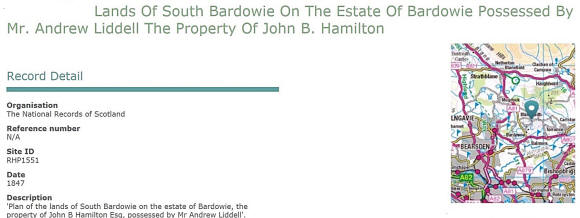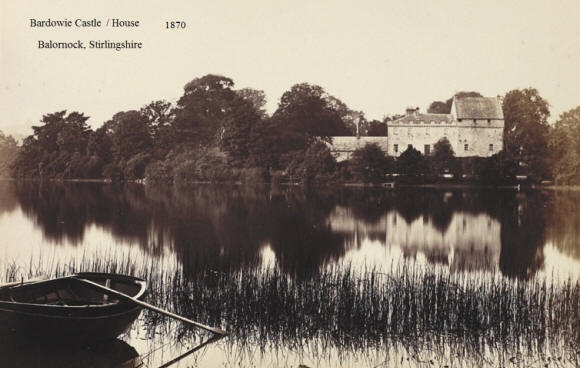|
See also page on David Dale
Hi Alastair,
My Carron Iron Works’ discoveries led me back to my Great Founders
story, and it brought out two more candidates for Significant Scots. My
GGG Grand Uncle Andrew Liddell [1789-1854] and his industrial
relationship with my 1st Cousin four times removed, his nephew Robert
MacLaren [1817-1889] the main subject of the ‘founders’ pdfs that pop up
from the URL above.
Context Abbreviated
1. Margaret Lawrie . My Great Great Great Great Grandmother who married
twice!
Margaret married (1) Robert Maclaren.
They had the following children:
+ 2 F i. Margaret Maclaren was christened on 19 Jun 1775. She died on 31
Dec 1817. My Great Great Great Grandmother
+ 3 M ii. Robert Maclaren [Sub-manager of Carron Iron Works - Baptist
Minister] was born about 1778. He died on 11 Aug 1826.
Margaret married (2) Andrew Liddell [Sub-manager of Carron Iron Works]
on 10 Jun 1786 in Larbert Stirling Scotland. Brother Uterine of Robert
MacLaren above
They had the following children:
4 iii. Unknown Liddell was christened on 30 Dec 1787 in Falkirk Stirling
Scotland.
5 M iv. Andrew Liddell was born on 13 Dec 1789 in Falkirk Stirling
Scotland. He was christened on 20 Dec 1789 in Falkirk Stirling Scotland.
He died on 15 Nov 1854 in Bardowie House, Baldernock Stirling Scotland.
The cause of death was Bilious Fever.
Andrew married (1) Janet Goodsir on 11 Jan 1820 in Glasgow Scotland.
Andrew married (2) Jessie Peddie.
"Andrew Liddell & Co."
- [Owner Andrew Liddell (1789-1854)]
"Robert MacLaren & Co." - [Owner Robert MacLaren (1817-1889)]
An article by John Henderson based on research done by the following
bodies...
'Mackintosh Architecture' led by The Hunterian, University of Glasgow,
funded by the Arts and Humanities Research Council; with additional
support from The Monument Trust, The Pilgrim Trust, and the Paul Mellon
Centre for Studies in British Art; and collaborative input from Historic
Scotland and the Royal Commission on the Ancient and Historical
Monuments of Scotland.
Robert Maclaren & Co. operated the Eglinton Foundry on the south side of
the river Clyde for over 70 years. Robert Maclaren (1817-1889), son of a
manager at Carron Ironworks, Falkirk, established his own firm when
taking over his Uncle Andrew Liddell's 'patent gas-tube and lap-welded'
pipe company named "Andrew Liddell & Co.", at the Globe Foundry in
Washington Street, in 1844. Around twelve years later, the firm
relocated to Eglinton Foundry, where business continued until 1931.
By 1888, the works covered an area of 26,000 square yards and employed
between 600 and 800 men. Sixty per cent of the premises were given over
to the storage of 'many thousands of tons of cast-iron pipes ... ready
for shipment'. By 1901, the Foundry was 'producing 30,000 tons of pipes
annually for water, gas or electric purposes'. This growth in the
manufacture of cast-iron pipes was attributed to increasing standards in
domestic sanitation and power-supplies. The Foundry's production process
and mould-drying ovens were semi-automated with hydraulic, gas and
electric-power, and it had its own dedicated railway sidings and a
five-ton travelling crane. The firm was innovative and introduced
standardised pipe dimensions, which were subsequently adopted
industry-wide.
Robert MacLaren Junior (c. 1860-1936) later took over the running of the
firm and was also involved in Glasgow business life at a high level,
serving as a a director of Glasgow Chamber of Commerce and as chairman
of the Glasgow Royal Exchange for 18 years.
The firm supplied pipes to Liverpool Council (1889), for Edinburgh's
first electric street-lighting scheme (1893-4), and Glasgow's municipal
water-supply (1898; controversially beating a possibly-lower American
tender). In the 1900s, it exported to Brazil, India, Argentina and to
various Chilean coppermines. During the First World War, the Foundry
produced 'eight million fuse stampings' and worked with William
Beardmore, of Parkhead Forge, to construct tanks. In the 1920s, a
subsidiary firm, Eglinton Founders Ltd, was established with Beardmore
as co-partner. Also in the 1920s, Robert Maclaren & Co. produced
thermostats and temperature controls. In 1931, the firm was wound up;
shortly afterwards a new firm was established under the same name with
new investment.
References:
1: John Henderson, Great Founders of Falkirk and Glasgow,
www.electricscotland.com/poetry/henderson/, pdf file, pp. 4-6 [accessed
21 March 2013]; 'Memoirs: Andrew Liddell 1786-1855’, Proceedings of the
Institution of Civil Engineers, 15,1855-6, pp. 102-3; Glasgow Post
Office Directory, 1844-5, p. 151; 1845-6, p. 193; 1846-7, p. 158:
Belfast News-Letter, 11 August 1846, p. 3.
2: Glasgow Herald, 17 October 1856, p. 7; Glasgow Post Office Directory,
1857-8, p. 177.
3: Glasgow of Today: Metropolis of the North, London: Historical
Publishing Co., 1888, p. 119; Henry Dyer, 'Mechanical Engineering', in
Angus McLean, ed., Local Industries of Glasgow, Glasgow: British
Association, 1901, pp. 80-2.
4: Henry Dyer, 'Mechanical Engineering' in Angus McLean, ed., Local
Industries of Glasgow, Glasgow: British Association, 1901, pp. 81-2.
5: Scotsman, 6 May 1936, p. 12; 'I. G. MacLaren, Robert MacLaren &
Company, Ltd,' 1962, quoted in John Henderson, Great Founders of Falkirk
and Glasgow, www.electricscotland.com/poetry/henderson/, pdf file, pp.
13-14 [accessed 21 March 2013].
6: Liverpool Mercury, 6 June 1889, p. 3; Scotsman, 10 April 1895, p. 9;
16 September 1898, p. 7.
7: Scotsman, 26 Jun 1907, p. 12.
8: Scotsman, 19 July 1934, p. 5; 6 May 1936, p. 12; 'I. G. MacLaren,
Robert MacLaren & Company, Ltd,' 1962, quoted in John Henderson, Great
Founders of Falkirk and Glasgow, www.electricscotland.com/poetry/henderson/,
pdf file, pp. 13-14 [accessed 21 March 2013].
Obituary of Andrew Liddell from the 'ICE Publishing Journal' -
'Essential Engineering Knowledge' Extracted by his Great Great Great
Grand Nephew, John Henderson BA, DPE, PGCE of Stirling, Scotland
Mh. ANDREW LIDDELL, was bom in 1789 in the village of Bainsford, near
Falkirk, where he received the elements of his education from his
Father, who wa9 originally a schoolmaster, but subsequently obtaining an
appointment as clerk in the Carron Iron Works, he employed his son as
assistant. At eighteen years of age young Liddell proceeded to
Edinburgh, and obtained a situation in a foundry, and afterwards, at a
metal-morehant’s at Leith. He had, at this time, serious thoughts of
becoming a surgeon, and followed, with that view, some of the University
classes ; his employers kindly permitting him to write up his books at
night, in order to afford him time to attend the College during the day.
He, however, relinquished this object, on being offered a partnership in
an ironmongery establishment in Glasgow, where he eventually settled in
181+ or 1815. In a few years, his partners retired, and, with an advance
of capital from his half-brother, Mr. Roliert McLaren, be became the
head of the firm of Andrew Liddell and Co., and thus continued till
18++, when he relinquished the business in favour of his nephew, lie
carried on the most extensive manufacture in Scotland, of wrought-iron
tubes, employing a method of welding, somewhat similar to that
introduced by Mr. Janies llussell, of Wednesbnry. On the general
introduction of gas, be became engaged in manufacturing gas-pipes and
apparatus, which he supplied to many towns in Scotland and Ireland, and
extensively exported to Nova Scotia and Canada.
Ilis early scientific education and practical knowledge of mechanics,
led him to take great interest in the proceedings of the British
Association, and his exertions mainly contributed to determining the
Meeting of that body at Glasgow, in 18+1. He again volunteered his
services in 1854, and was one of the deputation sent to Liverpool for
the purpose of arranging for the Meeting in 1856. He was admitted a
Member of the Philosophical Society of Glasgow, in 1819, was frequently
elected President, and held, for many years, the office of Treasurer. It
was chiefly through his indomitable perseverance, that the Society was
at one period of its existence, saved from dissolution : and it is
related, that, not un-frequently, the meeting consisted but of himself
and another member, who, however, duly entered the proceedings in the
minutes. In connection with this Society, he took a leading part in
organizing the exhibition of the operations and products of the arts and
sciences, which took place at Glasgow, at the end of 18+6 and beginning
of 18+7, and which was visited by nearly one hundred thousand persons.
He was an authority on all matters connected with patent inventions, and
a well-read man in general literature : of his talents as a biographer,
he lots left a specimen, in the life of David Dale, which he contributed
to Messrs. lllackie’s ‘Lives of Eminent Scotsmen.’ In 1843, he joined
the Institution of Civil Engineers as an Associate, took much interest in its
proceedings and welfare, and was a regular attendant whenever he came to
London.
As a Magistrate, he lias left a well-earned reputation for inflexible
impartiality; and, as a philanthropist, for his strenuous exertions in
the cause of temperance, and his unwearied efforts in favour of the
distressed. The Night Asylum for the Houseless, which he was the means
of establishing in Glasgow, will ever remain a monument of his practical
benevolence, lie was a member of the Scottish Baptist Connexion, and on
his retirement from business, became the pastor of a church, in
Brown-street, which he had purchased and presented for the use of the
congregation. lie died from an attack of bilious fever, on the 15th of
November, 1854 , at his residence, Bardowie House, aged sixty-four;
having passed the latter years of his life in the society of his
attached friends, and the enjoyment of his happy home.

N.B. "I have corrected the original entries for the birth and death
dates of my GGG Grand Uncle, and added further details on his birth as
the 13th of December, 1789" says John Henderson in 2014.

1870 photo of the death residence of Andrew Liddell in 1854
Modified Register for Margaret Lawrie
|

